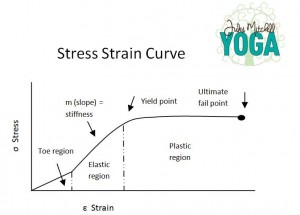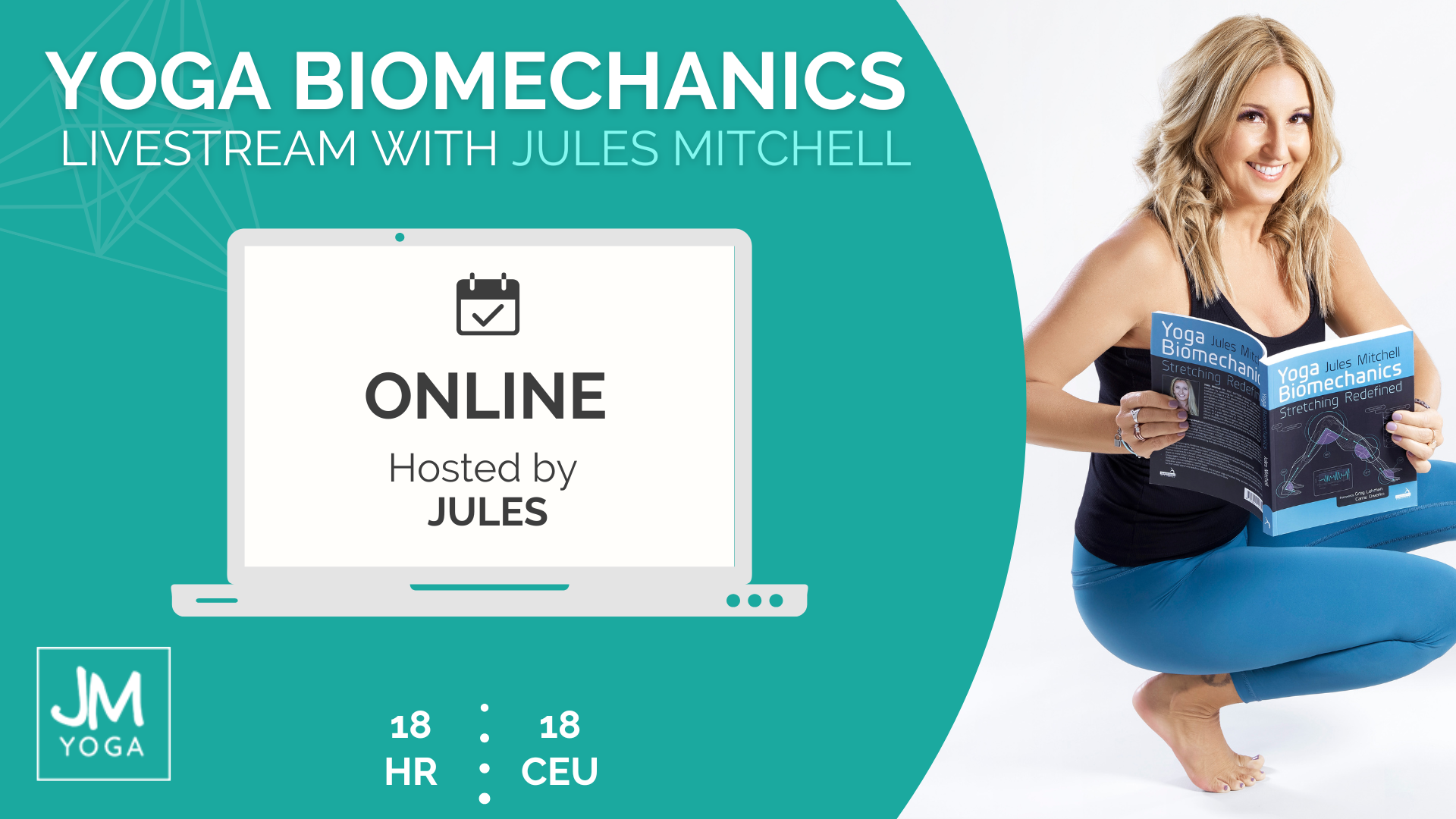In mechanical terms, range is how much strain (deformation) a material can withstand while stiffness is how much stress (load) something can withstand. Basically, range is how far something can stretch.
Range for human connective tissues is somewhere around 4% before the collagen starts to break and around 8% for total tear (ultimate failure). Here’s the stress strain curve again:
What’s so interesting about range? Because we define flexibility as having adequate range of motion¹. If your collagen fibers maintain structural integrity at a range of about 4%, then your stretching activities should probably not emphasize pushing the limits of this range. If you stretch harder, you won’t actually increase the range of your connective tissue. You will just break them.
Let’s use a gummy worm as an example. Gummy worms are made of hydrolysed collagen (gelatin) so they work well as an analogy. If you stretch a gummy worm about 4%, it still manages to hold itself together. But stretch it more and more, and it will start to stretch apart, literally. Don’t do that to your connective tissue!
If something is limiting your range, the cause is often blamed any number of things: tissue length (shortness), fibrosis (scarring), osteoarthritis in the joint, neuromuscular interference, just to name a few, albeit unlikely, explanations. If you look up at the stress strain curve, tissues that don’t have range could be called unyielding. I like the word unyielding because it doesn’t immediately assume to know the mechanism causing the limited range. Either way, if you are trying to improve flexibility, you still don’t want to stretch your collagen tissues past the range of about 4%.
Just for conversation, let’s assume the tissues aren’t long enough and that is what is hindering flexibility. The solution to increasing your range to an average level of flexibility is not to stretch harder and longer – like those wickedly popular 5 minute passive stretches without support. You would rather stretch frequently and with the right amount of force so the tissues to adapt to the demands placed upon them. Get yourself a bolster already!
But how much load is the right amount of force? Remember stiffness? If your connective tissues lack stiffness, the load will need to be less. Unfortunately, this is hard to determine and is variable among individuals. It makes teaching yoga to a group of people a very difficult thing to do – if you are at all concerned about overstretching. If you are not concerned about tissue damage, then carry on. And send me a copy of your awesome playlist.
A big misunderstanding around flexibility is the failure to distinguish between range and stiffness. When connective tissues lack stiffness, the range does not actually increase. It just means the tissue can withstand less load (it’s weaker). The opposite of stiffness would be pliability. Pliable connective tissues will deform under low loads. Pliable connective tissues are associated with unstable joints.
Let’s look at an example to make sense of all this range and stiffness business.
The ankle joint is totally enveloped in connective tissues. If you want to increase the range of an inflexible ankle joint, you don’t want to decrease the stiffness. If you decrease the stiffness of ankle ligaments, you are much more likely to sprain your ankle if you trip and “twist” your ankle. The stiffer your ankle ligaments, the better you can avoid injury under unexpected and high loads. In addition, previously sprained ankles are found to lack stiffness when compared to healthy ankles². This reduction in stiffness is not the same as increasing your range. To increase the range, you’d have to address the mechanism that is preventing yield.
_______________________________________________________
1 Garber, C. E., Blissmer, B., Deschenes, M. R., Franklin, B. a, Lamonte, M. J., Lee, I.-M., … Swain, D. P. (2011). American College of Sports Medicine position stand. Quantity and quality of exercise for developing and maintaining cardiorespiratory, musculoskeletal, and neuromotor fitness in apparently healthy adults: guidance for prescribing exercise. Medicine and Science in Sports and Exercise, 43(7), 1334–59. doi:10.1249/MSS.0b013e318213fefb
2 Kovaleski, J. E., Heitman, R. J., Gurchiek, L. R., Hollis, J. M., Liu, W., & Pearsall, A. W. (2014). Joint Stability Characteristics of the Ankle Complex in Female Athletes With Histories of Lateral Ankle Sprain, Part II: Clinical Experience Using Arthrometric Measurement. Journal of Athletic Training, 49(2). doi:10.4085/1062-6050-49.2.08
Extend Your Learning: Online Education With Jules
Yoga Biomechanics Livestream
My flagship 3-day livestream course is for teachers who have an insatiable curiosity about human movement and kinesiology, are eager to know what the research says about yoga, and are open to accepting that alignment rules aren’t always accurate. Includes 30 days of access to the livestream replay and slides. 18 CEUs. Learn more >




As always, Jules, you explain so well and so clearly. I benefit greatly from your postings–I am ever more mindful whether I’m in a yoga class, on a walk or bike ride, even just sitting down to watch some tv. Thank you!
Thanks for the note Kathy!!! I’m so happy my blogs are being read. Feel free to share with anyone. 🙂 Love, Jules
so from a “range” perspective… building “stiffness” or stability FIRST is important? does that relate to STRENGTH or is that different as we are talking just connective not muscle tissue? and by connective you are talking fascia as well as tendons and ligaments?
I am talking about all collagen based soft connective tissues: ligaments, tendons, and fascia. They all vary in their behaviors somewhat, but the big picture is the same. It will get very complicated very fast if we differentiate, so we have to learn general concepts first.
Stiff collagen is strong, it can resist damage under tensile loads. I’m not talking about muscle strength. That would be force production.
It’s not that stiffness needs to be addressed before range. It’s more a question of training goals and potential demands. So, it’s difficult to answer theoretically. What is the scenario and what is the goal and then we can dive in for a deeper conversation?
Good questions!!!!!!!!